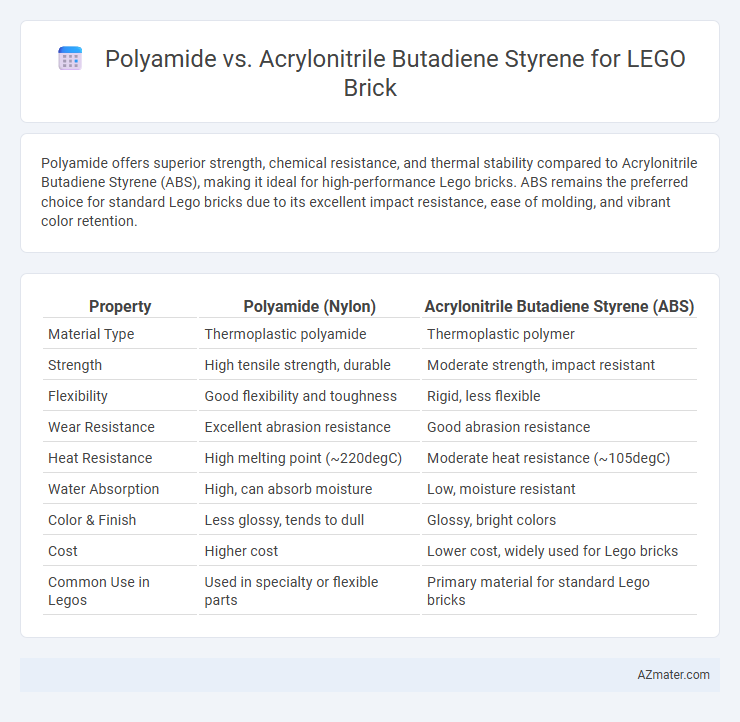Polyamide offers superior strength, chemical resistance, and thermal stability compared to Acrylonitrile Butadiene Styrene (ABS), making it ideal for high-performance Lego bricks. ABS remains the preferred choice for standard Lego bricks due to its excellent impact resistance, ease of molding, and vibrant color retention.
Table of Comparison
| Property | Polyamide (Nylon) | Acrylonitrile Butadiene Styrene (ABS) |
|---|---|---|
| Material Type | Thermoplastic polyamide | Thermoplastic polymer |
| Strength | High tensile strength, durable | Moderate strength, impact resistant |
| Flexibility | Good flexibility and toughness | Rigid, less flexible |
| Wear Resistance | Excellent abrasion resistance | Good abrasion resistance |
| Heat Resistance | High melting point (~220degC) | Moderate heat resistance (~105degC) |
| Water Absorption | High, can absorb moisture | Low, moisture resistant |
| Color & Finish | Less glossy, tends to dull | Glossy, bright colors |
| Cost | Higher cost | Lower cost, widely used for Lego bricks |
| Common Use in Legos | Used in specialty or flexible parts | Primary material for standard Lego bricks |
Introduction to Lego Brick Materials
Lego bricks are primarily made from Acrylonitrile Butadiene Styrene (ABS), prized for its excellent strength, durability, and vibrant color retention. Polyamide, or nylon, offers superior abrasion resistance and flexibility but lacks the rigidity needed for precise brick connections. The choice of ABS ensures optimal performance in maintaining the interlocking functionality and long-lasting quality that Lego bricks require.
Understanding Polyamide: Properties and Uses
Polyamide, commonly known as nylon, offers exceptional strength, heat resistance, and flexibility, making it a durable material choice for high-stress Lego bricks that require longevity and impact resistance. Its superior wear resistance and ability to withstand repeated mechanical stress differentiate it from Acrylonitrile Butadiene Styrene (ABS), which is more brittle but easier to mold and widely used in standard Lego bricks for vibrant color and precision. Polyamide's moisture absorption and higher production cost limit its use to specialized Lego components where enhanced durability and thermal stability are critical.
What is Acrylonitrile Butadiene Styrene (ABS)?
Acrylonitrile Butadiene Styrene (ABS) is a thermoplastic polymer commonly used in manufacturing high-quality LEGO bricks due to its excellent impact resistance, toughness, and glossy finish. ABS provides superior durability and color stability, ensuring LEGO pieces maintain their shape and vibrancy over time without warping or fading. Compared to polyamide, ABS offers better ease of molding and consistent dimensional accuracy, making it the preferred material for precision toy components.
Mechanical Strength Comparison
Polyamide (PA) exhibits superior mechanical strength and impact resistance compared to Acrylonitrile Butadiene Styrene (ABS), making it more durable under high stress conditions in Lego brick applications. PA's inherent toughness and higher tensile strength enhance the longevity and resistance to deformation of Lego bricks during repetitive assembly and disassembly. However, ABS maintains sufficient strength with better rigidity and surface finish, which supports consistent interlocking performance and aesthetic appeal in Lego manufacturing.
Durability and Longevity in Lego Bricks
Polyamide offers superior durability and resistance to wear, making it highly suitable for Lego bricks subjected to frequent handling and stress. Acrylonitrile Butadiene Styrene (ABS), the traditional material for Lego bricks, provides excellent impact resistance and color retention but may degrade faster under UV exposure and heat. The enhanced toughness and chemical resistance of polyamide contribute to longer-lasting bricks with less deformation and surface wear over time.
Color and Finish Retention
Polyamide, known for its superior resistance to UV radiation and chemical exposure, offers excellent color and finish retention for Lego bricks, preventing fading and surface degradation over time. Acrylonitrile Butadiene Styrene (ABS), the traditional material used in Lego bricks, provides vibrant colors and a smooth, glossy finish but may yellow and lose shine when exposed to prolonged sunlight or heat. Both materials ensure durability, but Polyamide's advanced weather resistance significantly enhances long-term aesthetic preservation for outdoor or high-exposure applications.
Manufacturing Considerations for Lego Bricks
Polyamide offers excellent mechanical strength and chemical resistance but requires higher molding temperatures and longer cooling times compared to Acrylonitrile Butadiene Styrene (ABS), impacting production speed for Lego bricks. ABS is preferred for Lego manufacturing due to its fast cycle times, ease of molding, and consistent color quality, facilitating efficient mass production. The thermal stability and lower shrinkage rate of ABS also enhance dimensional accuracy, critical for Lego's precise interlocking system.
Environmental Impact and Recyclability
Polyamide and Acrylonitrile Butadiene Styrene (ABS) differ significantly in environmental impact and recyclability for Lego bricks. Polyamide, a durable and semi-biodegradable polymer, has a lower carbon footprint and offers better potential for chemical recycling, reducing plastic waste. ABS, while highly resilient and commonly used, presents challenges in recyclability due to its mixed polymer composition and typically results in more landfill waste and higher environmental persistence.
Cost Efficiency and Market Availability
Polyamide offers higher durability and heat resistance compared to Acrylonitrile Butadiene Styrene (ABS), but comes at a significantly higher cost, making ABS the preferred choice for large-scale Lego brick production due to superior cost efficiency. ABS maintains excellent impact resistance and easy moldability, contributing to its widespread market availability and lower manufacturing expenses. The established global supply chain for ABS ensures steady material access, reinforcing its dominance over Polyamide in the highly competitive toy fabrication industry.
Choosing the Ideal Material: Polyamide vs ABS for Lego
Polyamide offers superior durability and flexibility compared to Acrylonitrile Butadiene Styrene (ABS), making it ideal for Lego bricks requiring enhanced impact resistance and longevity. ABS provides excellent color retention and surface finish, which is crucial for maintaining the vibrant appearance and precise interlocking features of Lego components. Choosing between polyamide and ABS depends on prioritizing either mechanical strength and wear resistance or aesthetic quality and moldability for the perfect Lego brick performance.

Infographic: Polyamide vs Acrylonitrile Butadiene Styrene for Lego Brick
 azmater.com
azmater.com